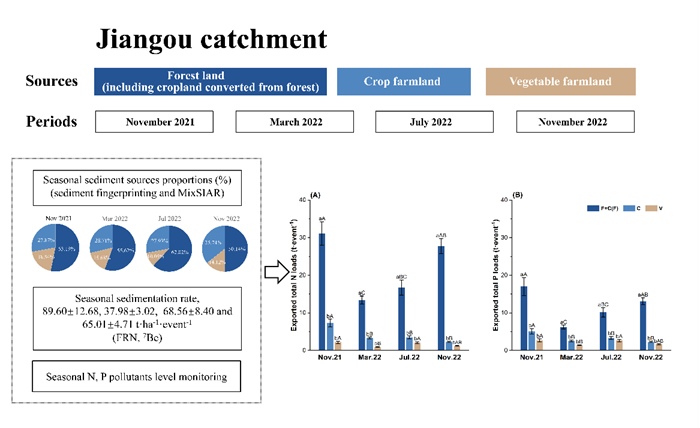Study reveals that land management policy shift influenced seasonal sediment nitrogen and phosphorus output sources and loads in agricultural catchment
Recently, the Agricultural Clean Watershed Research Team at the Institute of Environment and Sustainable Development in Agriculture, Chinese Academy of Agricultural Sciences (CAAS) successfully quantified in a cost-effective way the seasonal variation of sediment total nitrogen (TN) and total phosphorus (NP) output loads from land-use-specific sources in a catchment in the context of a land management policy shift by innovatively applying a combination of Berillium-7 (7Be) tracer and compound-specific stable isotope (CSSI) sediment fingerprinting. This approach also has the potential for application in other areas. These findings enable soil conservation strategies and land management practices optimized for implementing targeted pollutant abatement initiatives in intensive agriculture in China and elsewhere. The related research findings have been published in the Science of the Total Environment .
A policy shift towards intensive agricultural production and land management often leads to excessive fertilizer application and accelerated soil erosion with consequent detrimental effects to water bodies. How that shift affects the seasonal variation of sediment N and P output sources and loads in an agricultural catchment is vital to intensive prevention and control of non-point agricultural source pollution. The study monitored the contributions of different land uses to seasonal sources of sediment and its N and P pollutants as well as the variation of output loads in a small intensive agricultural catchment in North China across one year (November 2021-November 2022) following a shift in land management policies. To do so, the research team used 7Be tracer and CSSI fingerprinting combined with the MixSIAR model. The study suggests that sediment is mainly derived from forest land+cropland converted from forest (averaged 55.24±2.91%), followed by vegetable farmland (averaged 30.06±2.20%), and least from crop farmland (averaged 14.70±2.13%). Sedimentation rates ranged between 37.98±3.02-89.60±12.68 t·ha-1·event-1 in the catchment in different periods of time. Forest land+cropland converted from forest contributed the highest sediment N and P output loads at the catchment outlet in different periods of time, with the levels in the winter of 2021 and 2022 higher than that in the spring of 2022. The local policy-driven "forest-to-cropland conversion" is an important reason for forest land+cropland converted from forest being the top contributor to sediment in the catchment. In the short term, emphasis should be placed on slope maintenance and management for newly built high-standard cropland while reducing pollutants (by increasing the fertilizer efficiency).
This study was supported by the National Key Research and Development Program of China and the International Atomic Energy Agency Coordinated Research Project, among others.
Linkage:https://www.sciencedirect.com/science/article/pii/S0048969724007289

-
 Apr 18, 2024Opening Ceremony of the Training Workshop on Wheat Head Scab Resistance Breeding and Pest Control in Africa Held in CAAS
Apr 18, 2024Opening Ceremony of the Training Workshop on Wheat Head Scab Resistance Breeding and Pest Control in Africa Held in CAAS -
 Apr 03, 2024IPPCAAS Co-organized the Training Workshop on Management and Application of Biopesticides in Nepal
Apr 03, 2024IPPCAAS Co-organized the Training Workshop on Management and Application of Biopesticides in Nepal -
 Mar 28, 2024Delegation from the School of Agriculture and Food Science of University College Dublin, Ireland Visit to IAS, CAAS
Mar 28, 2024Delegation from the School of Agriculture and Food Science of University College Dublin, Ireland Visit to IAS, CAAS -
 Mar 25, 2024Director of World Food Prize Foundation visited GSCAAS
Mar 25, 2024Director of World Food Prize Foundation visited GSCAAS -
 Mar 20, 2024Institute of Crop Sciences (ICS) and Syngenta Group Global Seeds Advance Collaborative Research in the Seed Industry
Mar 20, 2024Institute of Crop Sciences (ICS) and Syngenta Group Global Seeds Advance Collaborative Research in the Seed Industry
